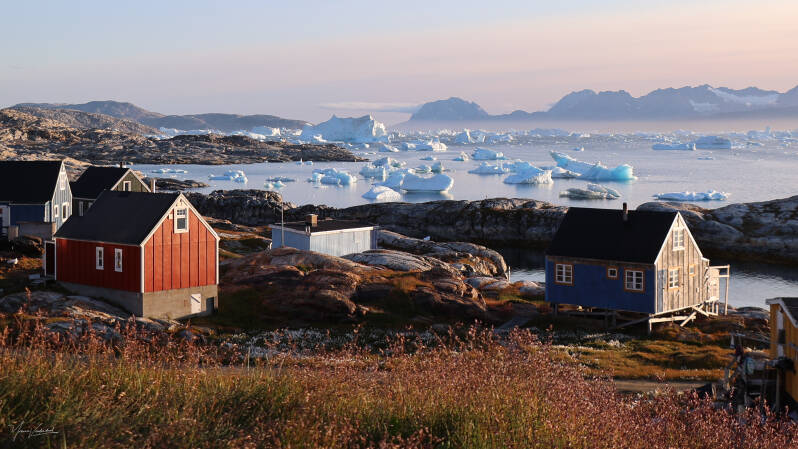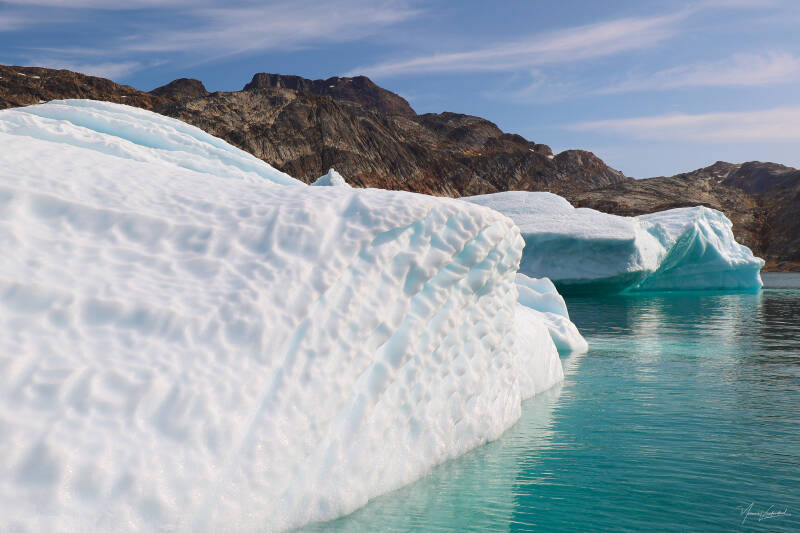As a travel destination, Greenland isn’t the most obvious choice. It’s remote, difficult to reach, and still relatively undeveloped. Accommodation and tours are limited — and it’s certainly not cheap. Yet for adventurers and nature lovers, Greenland is a destination like no other. In this story, I share my travel experiences and explain why you should put Greenland at the top of your bucket list.
Getting to Greenland
Reaching Greenland is an adventure in itself. The country isn’t designed for large-scale international travel. Flights depart mainly from Iceland, Denmark, and — in summer — North America, often requiring an overnight stay before and after your trip. In my case, I spent the first and last nights in Iceland, no complaints here. The landscape in Greenland is raw, the weather unpredictable, flights to Greenland are frequently delayed or canceled because of wind, snow, or fog. Temperatures typically range from –20 °C to 10 °C (–4 °F to 50 °F). To end up in Greenland, is an experience in itself. Runways are unpaved and from the plane you have breathtaking views of mountains, glaciers and floating icebergs. Once there, travel between towns is only possible by plane, boat, or helicopter. There are no roads connecting communities and many places are inaccessible for most of the year.
Largest Island
Greenland is the largest island on Earth, located between Canada and Iceland. Politically it belongs to Denmark, though it has self-governing since 1979. About 80 % of the island is covered by ice (the Greenland Ice Sheet), containing enough frozen water to raise global sea levels by seven meters if it melted entirely. Because of climate change, the ice is retreating faster every year. Fewer than 57,000 people live on the island, most of whom are of Inuit descent. The official language is Greenlandic, alongside Danish and increasingly English. Most people live on the west coast, around the capital Nuuk. Daily life and culture are deeply tied to nature and traditional hunting, though tourism is growing quickly.
East Greenland
After a few hours' delay due to fog, our small plane landed at Kulusuk. The east of Greenland is remote and even wilder and more isolated than the rest of the island. The arrival area was was a small building and we collected our luggage straight off a forklift. There are no roads, we walked along a dirt track to the water where a small boat awaited us. The scenery was stunning: sharp mountain peaks, drifting ice blocks and crystal-clear air. During the bumpy ride to Tasiilaq, we spotted whales, huskies on a island, massive glaciers, and icebergs the size of apartment buildings. Tasiilaq is a postcard-perfect town of brightly colored houses, accessible only five months a year. Only twice a year, a supply ship reaches this settlement. Dinner at our hotel was served only between 6 and 7 p.m. To my surprise, whale was on the menu.
Whale and Polar Bear Hunting
The next day we set out with a local captain who didn’t speak a word of English, heading toward the settlement of Tiniteqilaaq. Along the way, we saw several whales surfacing near the boat. Whales remain vital to Greenland’s diet, economy and traditions. The country has a quota of 200 whales per year. This only applies to minke and fin whales and not to the rare bowhead whale. Every part of the animal is used: meat, fat, and bones are consumed, crafted, or traded. Tradition dictates that a portion is shared freely within the community. Tiniteqilaaq has just 96 residents and no running water or electricity. Dried fish hang everywhere, and we even see a polar bear hide hanging. Licensed Inuit hunters are permitted to hunt 100–150 polar bears per year, a practice deeply rooted in survival and heritage.
Visit Greenland now!
Later that week, we explored an ice cave, climbed a glacier, photographed sunrises and sunsets, and spent our final night in Tulusuk. We even caught a brief glimpse of the Northern Lights. We're on the plane for the flight back, we notice that some suitcases are being left behind. After takeoff, we find out that the aircraft was too heavy. Fellow passengers said we're lucky to be on board ourselves. Honestly, I wouldn’t have minded staying a few extra days. Greenland is breathtaking with overwhelming landscapes and ancient traditions. It’s like traveling back in time. Tourism is still developing, Greenland is literally shifting. Go now, before it's no longer pure and untouched.
More remarkable facts
-
Around 20,000 Greenlandic Inuit live in Denmark. Never call them Eskimos, the word is considered offensive.
-
Husky pups often roam freely and you're allowed to pet them. Adult dogs are sled and hunting dogs and should never be touched.
-
Greenland has one of the highest suicide rates in the world, particularly among young men. This is due to social isolation, limited daylight, alcohol abuse and colonial trauma.
-
In the 1960s and 1970s, thousands of women were fitted with IUDs without consent, a policy intended to control population growth.
-
Only one in eight children attends secondary school, often requiring relocation to other towns or even Denmark.
-
In recent years, Greenland has drawn international attention after Donald Trump’s 2019 proposal to “buy” the island. Though officially rejected, the episode underscored Greenland’s strategic importance due to its location, minerals and potential oil and gas reserves. Diplomatic and economic ties have since expanded.




